A. B. Siddique
Evaluating Sparse Autoencoders for Monosemantic Representation
Aug 20, 2025Abstract:A key barrier to interpreting large language models is polysemanticity, where neurons activate for multiple unrelated concepts. Sparse autoencoders (SAEs) have been proposed to mitigate this issue by transforming dense activations into sparse, more interpretable features. While prior work suggests that SAEs promote monosemanticity, there has been no quantitative comparison with their base models. This paper provides the first systematic evaluation of SAEs against base models concerning monosemanticity. We introduce a fine-grained concept separability score based on the Jensen-Shannon distance, which captures how distinctly a neuron's activation distributions vary across concepts. Using Gemma-2-2B and multiple SAE variants across five benchmarks, we show that SAEs reduce polysemanticity and achieve higher concept separability. However, greater sparsity of SAEs does not always yield better separability and often impairs downstream performance. To assess practical utility, we evaluate concept-level interventions using two strategies: full neuron masking and partial suppression. We find that, compared to base models, SAEs enable more precise concept-level control when using partial suppression. Building on this, we propose Attenuation via Posterior Probabilities (APP), a new intervention method that uses concept-conditioned activation distributions for targeted suppression. APP outperforms existing approaches in targeted concept removal.
INTERPOS: Interaction Rhythm Guided Positional Morphing for Mobile App Recommender Systems
Jun 14, 2025Abstract:The mobile app market has expanded exponentially, offering millions of apps with diverse functionalities, yet research in mobile app recommendation remains limited. Traditional sequential recommender systems utilize the order of items in users' historical interactions to predict the next item for the users. Position embeddings, well-established in transformer-based architectures for natural language processing tasks, effectively distinguish token positions in sequences. In sequential recommendation systems, position embeddings can capture the order of items in a user's historical interaction sequence. Nevertheless, this ordering does not consider the time elapsed between two interactions of the same user (e.g., 1 day, 1 week, 1 month), referred to as "user rhythm". In mobile app recommendation datasets, the time between consecutive user interactions is notably longer compared to other domains like movies, posing significant challenges for sequential recommender systems. To address this phenomenon in the mobile app domain, we introduce INTERPOS, an Interaction Rhythm Guided Positional Morphing strategy for autoregressive mobile app recommender systems. INTERPOS incorporates rhythm-guided position embeddings, providing a more comprehensive representation that considers both the sequential order of interactions and the temporal gaps between them. This approach enables a deep understanding of users' rhythms at a fine-grained level, capturing the intricacies of their interaction patterns over time. We propose three strategies to incorporate the morphed positional embeddings in two transformer-based sequential recommendation system architectures. Our extensive evaluations show that INTERPOS outperforms state-of-the-art models using 7 mobile app recommendation datasets on NDCG@K and HIT@K metrics. The source code of INTERPOS is available at https://github.com/dlgrad/INTERPOS.
* 10 pages, 8 tables, 3 figures
What Users Value and Critique: Large-Scale Analysis of User Feedback on AI-Powered Mobile Apps
Jun 12, 2025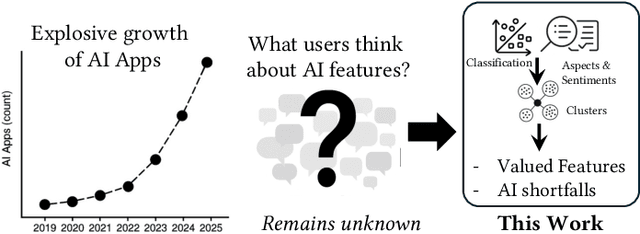
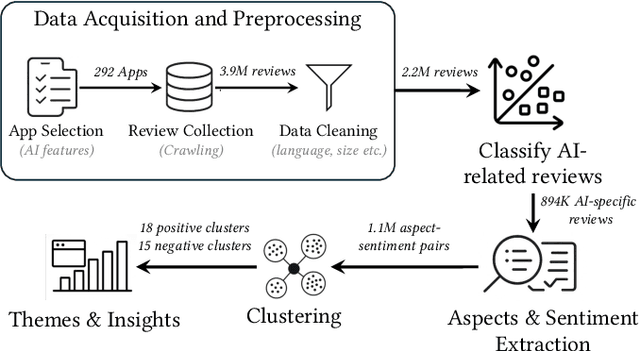
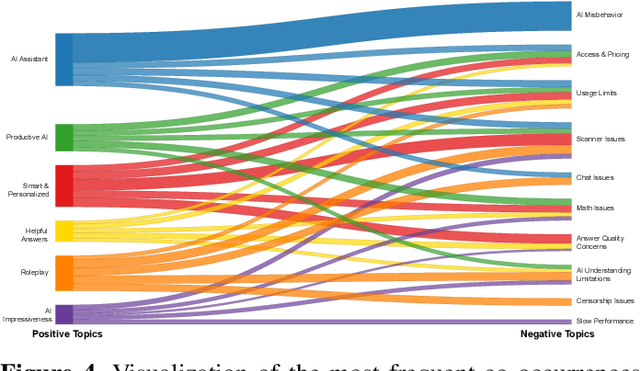
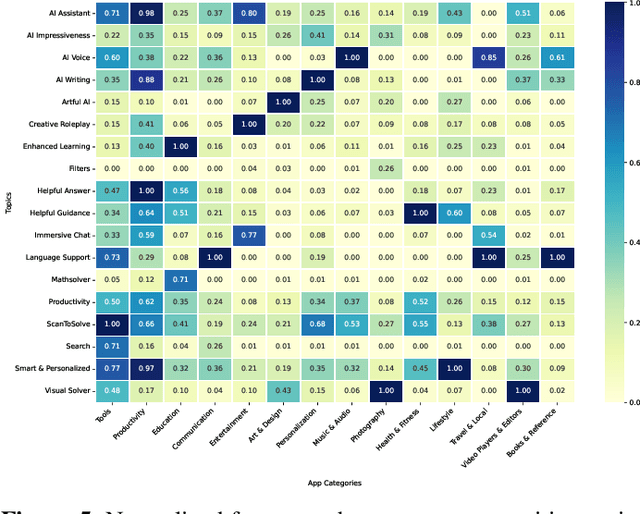
Abstract:Artificial Intelligence (AI)-powered features have rapidly proliferated across mobile apps in various domains, including productivity, education, entertainment, and creativity. However, how users perceive, evaluate, and critique these AI features remains largely unexplored, primarily due to the overwhelming volume of user feedback. In this work, we present the first comprehensive, large-scale study of user feedback on AI-powered mobile apps, leveraging a curated dataset of 292 AI-driven apps across 14 categories with 894K AI-specific reviews from Google Play. We develop and validate a multi-stage analysis pipeline that begins with a human-labeled benchmark and systematically evaluates large language models (LLMs) and prompting strategies. Each stage, including review classification, aspect-sentiment extraction, and clustering, is validated for accuracy and consistency. Our pipeline enables scalable, high-precision analysis of user feedback, extracting over one million aspect-sentiment pairs clustered into 18 positive and 15 negative user topics. Our analysis reveals that users consistently focus on a narrow set of themes: positive comments emphasize productivity, reliability, and personalized assistance, while negative feedback highlights technical failures (e.g., scanning and recognition), pricing concerns, and limitations in language support. Our pipeline surfaces both satisfaction with one feature and frustration with another within the same review. These fine-grained, co-occurring sentiments are often missed by traditional approaches that treat positive and negative feedback in isolation or rely on coarse-grained analysis. To this end, our approach provides a more faithful reflection of the real-world user experiences with AI-powered apps. Category-aware analysis further uncovers both universal drivers of satisfaction and domain-specific frustrations.
Improving Multi-turn Task Completion in Task-Oriented Dialog Systems via Prompt Chaining and Fine-Grained Feedback
Feb 18, 2025Abstract:Task-oriented dialog (TOD) systems facilitate users in accomplishing complex, multi-turn tasks through natural language. While traditional approaches rely on extensive fine-tuning and annotated data for each domain, instruction-tuned large language models (LLMs) offer a more flexible alternative. However, LLMs struggle to reliably handle multi-turn task completion, particularly with accurately generating API calls and adapting to new domains without explicit demonstrations. To address these challenges, we propose RealTOD, a novel framework that enhances TOD systems through prompt chaining and fine-grained feedback mechanisms. Prompt chaining enables zero-shot domain adaptation via a two-stage prompting strategy, eliminating the need for human-curated demonstrations. Meanwhile, the fine-grained feedback mechanism improves task completion by verifying API calls against domain schemas and providing precise corrective feedback when errors are detected. We conduct extensive experiments on the SGD and BiTOD benchmarks using four LLMs. RealTOD improves API accuracy, surpassing AutoTOD by 37.74% on SGD and SimpleTOD by 11.26% on BiTOD. Human evaluations further confirm that LLMs integrated with RealTOD achieve superior task completion, fluency, and informativeness compared to existing methods.
Evaluating and Enhancing Out-of-Domain Generalization of Task-Oriented Dialog Systems for Task Completion without Turn-level Dialog Annotations
Feb 18, 2025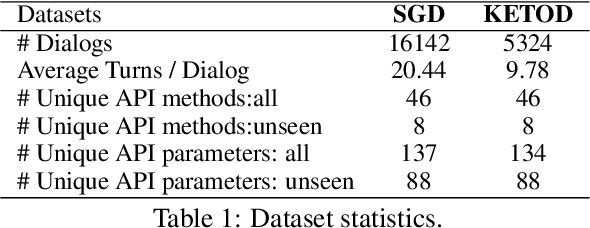
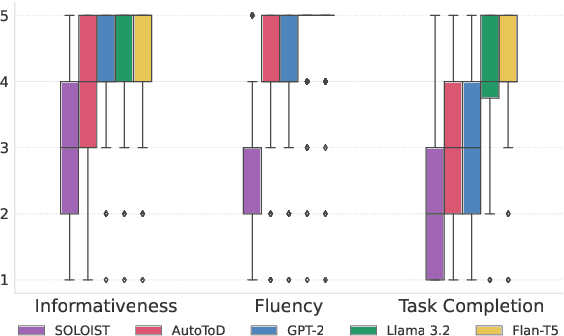
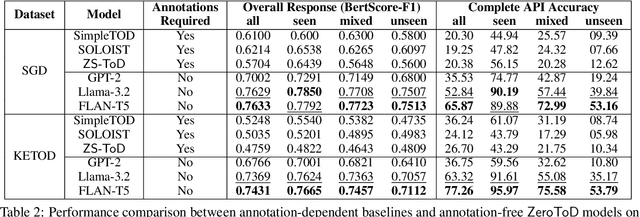
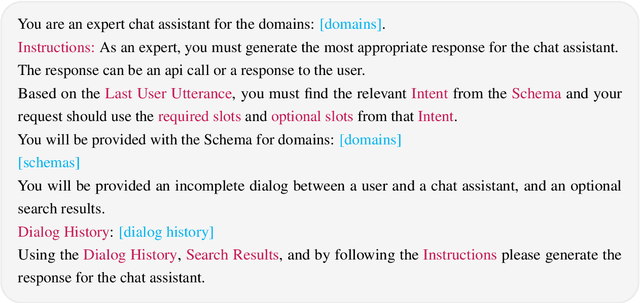
Abstract:Traditional task-oriented dialog (ToD) systems rely heavily on labor-intensive turn-level annotations, such as dialogue states and policy labels, for training. This work explores whether large language models (LLMs) can be fine-tuned solely on natural language dialogs to perform ToD tasks, without requiring such annotations. We evaluate their ability to generalize to unseen domains and compare their performance with models trained on fully annotated data. Through extensive experiments with three open-source LLMs of varying sizes and two diverse ToD datasets, we find that models fine-tuned without turn-level annotations generate coherent and contextually appropriate responses. However, their task completion performance - measured by accurate execution of API calls - remains suboptimal, with the best models achieving only around 53% success in unseen domains. To improve task completion, we propose ZeroToD, a framework that incorporates a schema augmentation mechanism to enhance API call accuracy and overall task completion rates, particularly in out-of-domain settings. We also compare ZeroToD with fine-tuning-free alternatives, such as prompting off-the-shelf LLMs, and find that our framework enables smaller, fine-tuned models that outperform large-scale proprietary LLMs in task completion. Additionally, a human study evaluating informativeness, fluency, and task completion confirms our empirical findings. These findings suggest the feasibility of developing cost-effective, scalable, and zero-shot generalizable ToD systems for real-world applications.
Natural Language Task-Oriented Dialog System 2.0
Jul 21, 2024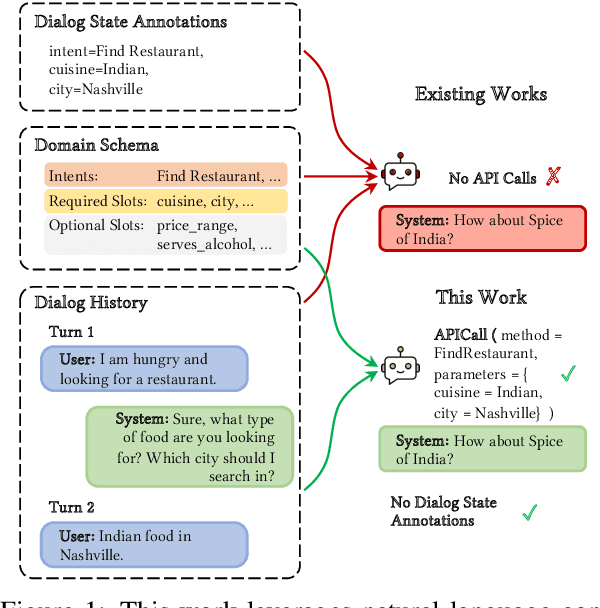



Abstract:Task-oriented dialog (TOD) systems play a crucial role in facilitating efficient interactions between users and machines by focusing on achieving specific goals through natural language communication. These systems traditionally rely on manually annotated metadata, such as dialog states and policy annotations, which is labor-intensive, expensive, inconsistent, and prone to errors, thereby limiting the potential to leverage the vast amounts of available conversational data. A critical aspect of TOD systems involves accessing and integrating information from external sources to effectively engage users. The process of determining when and how to query external resources represents a fundamental challenge in system design, however existing approaches expect this information to provided in the context. In this paper, we introduce Natural Language Task Oriented Dialog System (NL-ToD), a novel model that removes the dependency on manually annotated turn-wise data by utilizing dialog history and domain schemas to create a Zero Shot Generalizable TOD system. We also incorporate query generation as a core task of the system, where the output of the system could be a response to the user or an API query to communicate with an external resource. To achieve a more granular analysis of the system output, we classify the output into multiple categories: slot filling, retrieval, and query generation. Our analysis reveals that slot filling is the most challenging TOD task for all models. Experimental results on three popular TOD datasets (SGD, KETOD and BiToD) shows the effectiveness of our approach as NL-ToD outperforms state-of-the-art approaches, particularly with a \textbf{31.4\%} and \textbf{82.1\%} improvement in the BLEU-4 score on the SGD and KETOD dataset.
Looking into Black Box Code Language Models
Jul 05, 2024



Abstract:Language Models (LMs) have shown their application for tasks pertinent to code and several code~LMs have been proposed recently. The majority of the studies in this direction only focus on the improvements in performance of the LMs on different benchmarks, whereas LMs are considered black boxes. Besides this, a handful of works attempt to understand the role of attention layers in the code~LMs. Nonetheless, feed-forward layers remain under-explored which consist of two-thirds of a typical transformer model's parameters. In this work, we attempt to gain insights into the inner workings of code language models by examining the feed-forward layers. To conduct our investigations, we use two state-of-the-art code~LMs, Codegen-Mono and Ploycoder, and three widely used programming languages, Java, Go, and Python. We focus on examining the organization of stored concepts, the editability of these concepts, and the roles of different layers and input context size variations for output generation. Our empirical findings demonstrate that lower layers capture syntactic patterns while higher layers encode abstract concepts and semantics. We show concepts of interest can be edited within feed-forward layers without compromising code~LM performance. Additionally, we observe initial layers serve as ``thinking'' layers, while later layers are crucial for predicting subsequent code tokens. Furthermore, we discover earlier layers can accurately predict smaller contexts, but larger contexts need critical later layers' contributions. We anticipate these findings will facilitate better understanding, debugging, and testing of code~LMs.
MobileConvRec: A Conversational Dataset for Mobile Apps Recommendations
May 28, 2024Abstract:Existing recommendation systems have focused on two paradigms: 1- historical user-item interaction-based recommendations and 2- conversational recommendations. Conversational recommendation systems facilitate natural language dialogues between users and the system, allowing the system to solicit users' explicit needs while enabling users to inquire about recommendations and provide feedback. Due to substantial advancements in natural language processing, conversational recommendation systems have gained prominence. Existing conversational recommendation datasets have greatly facilitated research in their respective domains. Despite the exponential growth in mobile users and apps in recent years, research in conversational mobile app recommender systems has faced substantial constraints. This limitation can primarily be attributed to the lack of high-quality benchmark datasets specifically tailored for mobile apps. To facilitate research for conversational mobile app recommendations, we introduce MobileConvRec. MobileConvRec simulates conversations by leveraging real user interactions with mobile apps on the Google Play store, originally captured in large-scale mobile app recommendation dataset MobileRec. The proposed conversational recommendation dataset synergizes sequential user-item interactions, which reflect implicit user preferences, with comprehensive multi-turn conversations to effectively grasp explicit user needs. MobileConvRec consists of over 12K multi-turn recommendation-related conversations spanning 45 app categories. Moreover, MobileConvRec presents rich metadata for each app such as permissions data, security and privacy-related information, and binary executables of apps, among others. We demonstrate that MobileConvRec can serve as an excellent testbed for conversational mobile app recommendation through a comparative study of several pre-trained large language models.
Search Beyond Queries: Training Smaller Language Models for Web Interactions via Reinforcement Learning
Apr 16, 2024Abstract:Traditional search systems focus on query formulation for effective results but face challenges in scenarios such as product searches where crucial product details (e.g., size, color) remain concealed until users visit specific product pages. This highlights the need for intelligent web navigation agents capable of formulating queries and navigating web pages according to users' high-level intents. In response to this need, this work introduces a Grounded Language Agent for Intelligent Web Interactions, called GLAINTEL. Drawing upon advancements in language modeling and reinforcement learning, GLAINTEL investigates the efficacy of transformer-based models in enhancing the search capabilities of interactive web environments. Given the dynamic action space for each state in web navigation, GLAINTEL employs the Flan-T5 architecture and incorporates language modeling and value estimation heads. This work focuses on training smaller language models as agents across various scenarios, systematically evaluating the impact of human demonstrations on the training process. Specifically, we investigate scenarios where no human demonstrations are available and subsequently assess the effective utilization of such demonstrations. We also explore unsupervised domain adaptation for situations where demonstrations are confined to a specific domain. Experimental evaluations across diverse setups demonstrate the effectiveness of training agents in unsupervised settings, outperforming in-context learning-based approaches that employ larger models with up to 540 billion parameters. Surprisingly, behavioral cloning-based methods that straightforwardly use human demonstrations do not outperform unsupervised learning-based methods. Additionally, combining human demonstrations with Reinforcement Learning-based training yields results comparable to models utilizing GPT-4.
Zero-Shot Generalizable End-to-End Task-Oriented Dialog System using Context Summarization and Domain Schema
Mar 28, 2023Abstract:Task-oriented dialog systems empower users to accomplish their goals by facilitating intuitive and expressive natural language interactions. State-of-the-art approaches in task-oriented dialog systems formulate the problem as a conditional sequence generation task and fine-tune pre-trained causal language models in the supervised setting. This requires labeled training data for each new domain or task, and acquiring such data is prohibitively laborious and expensive, thus making it a bottleneck for scaling systems to a wide range of domains. To overcome this challenge, we introduce a novel Zero-Shot generalizable end-to-end Task-oriented Dialog system, ZS-ToD, that leverages domain schemas to allow for robust generalization to unseen domains and exploits effective summarization of the dialog history. We employ GPT-2 as a backbone model and introduce a two-step training process where the goal of the first step is to learn the general structure of the dialog data and the second step optimizes the response generation as well as intermediate outputs, such as dialog state and system actions. As opposed to state-of-the-art systems that are trained to fulfill certain intents in the given domains and memorize task-specific conversational patterns, ZS-ToD learns generic task-completion skills by comprehending domain semantics via domain schemas and generalizing to unseen domains seamlessly. We conduct an extensive experimental evaluation on SGD and SGD-X datasets that span up to 20 unique domains and ZS-ToD outperforms state-of-the-art systems on key metrics, with an improvement of +17% on joint goal accuracy and +5 on inform. Additionally, we present a detailed ablation study to demonstrate the effectiveness of the proposed components and training mechanism
 Add to Chrome
Add to Chrome Add to Firefox
Add to Firefox Add to Edge
Add to Edge